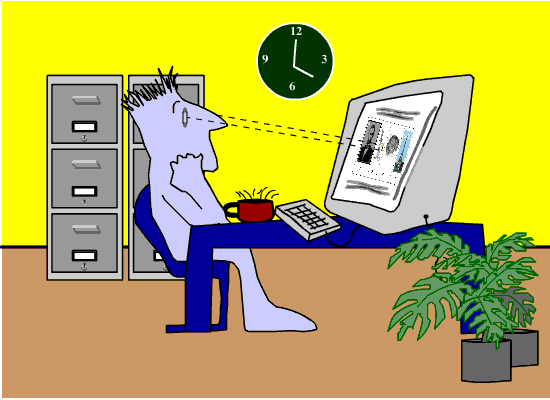Return to MODULE PAGE
Introduction to Perception (Page 2)
Rob Stufflebeam: Author
To be sure, you see Bugs Bunny. But is Bugs the ONLY object you see when you look at image B on your computer monitor? Of course not. And like you, the person depicted in the scene below is also seeing a great deal more than the image of Bugs alone, the object of his visual perception.

Working outwards, the person above also sees these "things" (among others):
- images of Abraham Lincoln, a brain, and the Eiffel Tower
- the text surrounding the 4-part image
- the scrollbar to the right of the webpage
- the boundary of the computer monitor
- the desk, keyboard, and coffee cup
- the front, left, and right walls
- the clock and part of the filing cabinet to his left
- the plant to his right
- his right arm, etc
What additional objects were you seeing while you attended to the image of Bugs? Now comes the key question: Were you AWARE of all those visual sensations while you attended to the image of Bugs? Alternatively, were you PERCEIVING all those other "things" simultaneously, even the ones at the periphery (edges) of your visual field?
The answer to each of theses question should be "No." Although you can direct your visual attention to any of the objects present in your field of view, you cannot attend to them all simultaneously. When you attend to a sensation, you are aware of it. Generally speaking, perception requires awareness, sensation does not. Hence, humans (and other perceiving creatures) sense more than they can perceive.
Of course, vision is not the only sense through which we perceive. Normal humans have 5 senses:
|
1 |
vision |
sight |
|
|
2 |
audition |
hearing |
 |
|
3 |
somatosensation |
touch |
|
|
4 |
olfaction |
smell |
|
|
5 |
gustation |
taste |
|
Not only can normal humans attend to and recognize their environment through the sensation of vision, they can also do these things through their other four senses too. So, to the list of visual sensations that you reported occurring while you perceived the image of Bugs Bunny, we can add these other sensations too:
audition (hearing)
- the sound of your computer
- the sound of your mouse as you move it on the mousepad
- the sound of your belly gurgling
- the sound of bubbles emanating from the can of soda on your desk
- the other background noises in your room, etc.
somatosensation (touch)
- the feel of the keys on your keyboard
- the feel of your shirt around your elbows
- the feel of your chair against your back
- the feel of the floor beneath your shoes, etc.
olfaction (smell)
- the smell of the coffee in the cup on your desk, or
- the smell of someone’s popcorn, or
- the smell of dirty laundry in the corner of your room, etc.
gustation (taste)
- the taste of toothpaste
- the lingering taste of the coffee, soda, or other drink beside you, etc.
Perception requires attention and awareness. If sensation were identical to perception, it would follow that we should be aware of each of the countless sensations that bombard our minds during each moment of consciousness. But we are not. Hence, sensation is NOT identical to perception. Thus, ‘vision’ and ‘visual perception’ name two different "things." And while most of the pages in this curriculum focus on visual perception, do not equate visual perception with perception itself. Auditory perception, somatosensory perception, olfactory perception, and gustatory [?] perception are kinds of perception too.
Perception matters
Is perception important? You bet! After all, intelligent action is necessary for our survival and perception lies at the heart of intelligent action. Examples are limitless. For instance, when you perceive an oncoming truck as dangerous while crossing the street, then move out of the truck’s way, your action is an intelligent one. So too are those when you remove yourself from danger after perceiving anything that might be hazardous to you or others, be it a dog, a person, an odor, a taste, an event, . . ., whatever. Of course, not all intelligent actions require the perception of harm or danger. Actions that bear upon our ability to acquire food, clothing, shelter, and relationships qualify as intelligent actions too. And without the ability to perceive, it would be impossible to achieve any of these goals, aims, or purposes.
In addition, perception is a seamless and ineliminable component of all our intelligent actions. Indeed, it is a seamless and ineliminable component of all our conscious experiences. Consequently, both for humans and for other intelligent systems, perception matters. Yet because we tend to take our ability to perceive for granted, you should consider just how different your life would be if you were to lose the ability to recognize faces, people, places, animals, objects, and/or events.
You are not being asked to consider what your life would be like if you were to lose a sense, although it is true that you would lose the perceptual abilities associated with a sense if you were to lose ability to see, to hear, to feel, to smell, or to taste. Rather, in the situation you are being asked to consider, assume that all of your senses continue working normally, but you lose the ability to recognize faces, people, places, animals, objects, and/or events nevertheless. If you were in this situation, you would suffer from a perceptual disorder, not a sensory one. There are many types of perceptual disorders. And as strange as it might sound, it is possible to lose the ability to perceive a particular kind of "thing." For example, consider the famous case of the man who mistook his wife for a hat (as reported by Dr. Oliver Sacks in his book by that name). The man in question suffered from a perceptual disorder called prosopagnosia (the inability to recognize faces). People who suffer from prosopagnosia (which is often precipitated by a stroke) retain the ability to "see" faces, but they lose the ability to recognize -- "perceive" -- as a face the anatomical pattern of a forehead, two eyes, a nose, a mouth, and a chin. Prosopagnosics can still recognize people, but they do so through other sensory cues: the color of an individual's hair, the sound of their voice, the smell of their perfume, etc. It is worth nothing that prosopagnosia is a type of visual agnosia (the inability to recognize objects through vision). Other kinds of vision-related perceptual disorders include loss of the ability to perceive a particular attribute of the visual world, such as color, form, or motion.
As this is not the appropriate place to explore perceptional disorders in any detail, the issue has been raised here for two reasons. The first is to underscore that perception is an essential component of the goal-directed lives of many kinds of intelligent systems. The second is to set the stage for the following "fact" about how perceiving intelligent systems do what they do. Namely, it's complicated.
For instance, did you report that A in the above experiment was a photograph of Abraham Lincoln (or words to that effect)? Well, consider what had to occur in your brain for you to perform this intelligent action. What began the process was the sensory input: As you attended to A on your monitor, light from that image was projected via the lenses in your eyes to your retinas at the back of your eyes. Those 2D retinal images of A, the sensory input, went through a series of transformations that resulted in the 3D image of A that you saw. (NOTE: Although the image of Lincoln on your computer monitor is not a 3D image, what you see in your visual field certainly is.) How the visual system goes from its impoverished input to its rich output is itself a very complex process. Basically, the transformations that make vision possible begin in your retinas, travel through the optic nerve to thalamic regions in the left and right portions of your brain, then are carried from there by visual information-specific pathways to the primary visual cortex in each of your two occipital lobes. As strange as it might sound, although your eyes are in the front of your head, you "see" as a result of information processing occurring in the back of your brain.
Later in the curriculum we shall revisit in greater detail how the visual system works. For now, note that all that has been described so far applies to visual sensation, NOT visual perception. To be aware of the 3D image you see AND to recognize it as a photograph of Lincoln requires even more processing. At the very least, you had to associate that image with a name (or concept) stored in your memory. Your brain then had to go through a series of transformations from that information to producing speech (which requires motor information processing) that resulted in your linguistic output.
For the sake of brevity, several parts of the story have been left out. Nevertheless, the take home message should be clear: Seemingly "easy" intelligent actions in humans occur only as a result of a complex series of internal information transformations. One of the main aims of cognitive science is to discover how this internal information processing occurs.
Studying perception
As you might expect, there are a host of questions about perception and its relation to intelligent action that cognitive scientists are attempting to resolve. Some of those question apply to human perception:
- How do our sensory systems work?
- What brain structures are involved and what are their functions?
- Why are humans susceptible to illusions, misperception, and perceptual disorders?
- When perceptual errors occur, where do they occur?
- How do our attentional mechanisms work?
- How are memories of names, faces, places, etc. stored and accessed?
- How is consciousness of what we perceive possible?
- Are human sensory and/or perceptual systems computational systems? If so, what kind of computational systems?
- Is it possible to build an artificial retina (or other sensory organ)?
- Is it possible to simulate human perceptual processing on a computer?
Other questions apply to perception in machines of human design and creation:
- Is it possible to build a machine that can visually perceive (that is, both see AND recognize objects in its environment)?
- Is it possible to build a creature that perceives as we do?
- Must artificial perceptual processing be computational processing?
- How can a machine be build that recognizes, say, danger, and then moves out of harms way? Alternatively, can an artificial perceiving creature be built that carries out intelligent actions?
- Does an artificial perceiving machine have a mind?
- How do you tell if an artificial creature has a mind?
Although these questions by no means exhaust the ones that engender cognitive scientific research into the nature of perception, they do represent a number of the issues that will be explored in the curriculum that follows. But as is the case in every other area of cognitive scientific research, perception can be studied only relative to a research method. Hence, let us turn our attention to what those methods are.








